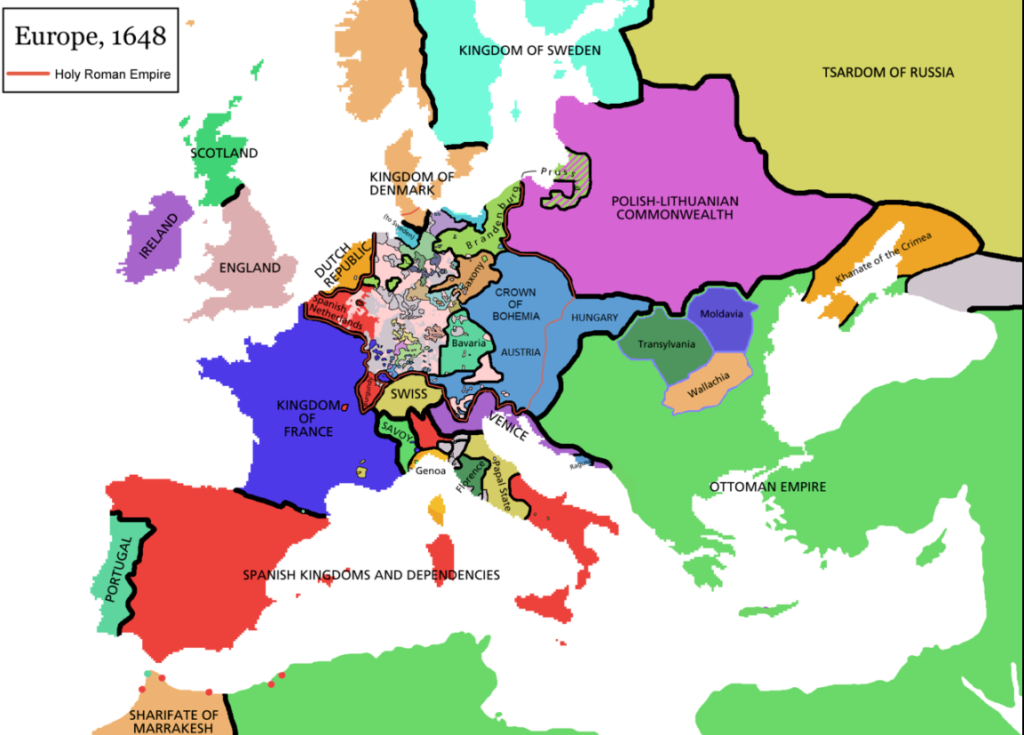
The Peace of Westphalia in 1648 marked a crucial turning point in European history. It brought an end to the Thirty Years’ War (1618–1648), a devastating conflict primarily fought in the Holy Roman Empire, and the Eighty Years’ War (1568–1648) between Spain and the Dutch Republic. This peace settlement had wide-reaching consequences, reshaping the political and religious landscape of Europe.
Key Outcomes:
- Sovereignty of States: The Peace of Westphalia is often seen as the foundation of the modern state system. It reinforced the idea that the authority of a ruler over their territory was supreme and not subject to external interference. This principle is known as sovereignty and laid the groundwork for the modern international system, where states are the primary actors in global politics.
- End of Religious Wars: The treaties effectively ended the religious conflicts between Catholics and Protestants that had plagued Europe for decades. The Holy Roman Empire, Spain, and France all had significant religious elements in their conflicts, but after the Peace of Westphalia, the principle of cuius regio, eius religio (the ruler’s religion determines the religion of the realm) was strengthened, meaning rulers could decide the religion of their own territories. However, this also led to certain guarantees for religious minorities, such as the recognition of Calvinism in the Holy Roman Empire.
- Territorial Changes: Several states gained or lost territories, shifting the balance of power in Europe:
- France gained territories in the western part of the Holy Roman Empire, including parts of Alsace and Lorraine.
- The Dutch Republic (the United Provinces) gained recognition of its independence from Spain, solidifying its status as a sovereign state after a long struggle.
- The Swedish Empire gained control over significant territories in the Baltic, including parts of northern Germany and control over certain territories of the Holy Roman Empire.
- The Holy Roman Empire lost territories to both France and Sweden but remained a loose confederation of various German states.
- Decline of the Holy Roman Empire: The Peace of Westphalia marked the beginning of the decline of the Holy Roman Empire. The emperor’s authority was weakened as many of the individual German states (which were already largely autonomous) gained more independence. This decentralized structure would persist until the dissolution of the Empire in 1806.
- Spain and the Dutch Republic: Spain, after its defeat in the Eighty Years’ War, acknowledged the independence of the Dutch Republic, a major shift in the power dynamics of Europe. Spain’s dominance was waning, and the Dutch became one of Europe’s most prosperous and powerful maritime nations.
Broader Impact:
- Rise of Modern Diplomacy: The treaties themselves were negotiated and signed in a manner that established many of the practices and protocols of modern diplomacy, including regularized state-to-state communications and the involvement of multiple parties in international discussions.
- Europe’s Fragmentation: While the Peace of Westphalia helped stabilize the continent, it also solidified Europe’s fragmented political landscape. The Holy Roman Empire, for example, remained a patchwork of loosely connected entities. The Treaty contributed to the development of a Europe where power was divided among many relatively independent states.
- Long-Term Peace: While the Peace of Westphalia did not immediately bring stability to all regions, it did mark the end of the era of religious wars in Europe. It allowed for the development of more secular forms of politics and international relations in the centuries that followed.
In summary, the Peace of Westphalia in 1648 had lasting consequences for European politics, significantly altering the structure of power, contributing to the rise of the modern nation-state, and helping to bring an end to religious warfare. The treaties also set the stage for a more balanced and decentralized European order, even if tensions and conflicts would continue in various forms.